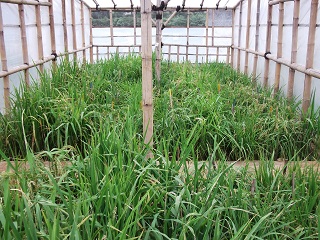A Group of IPB researchers: Differences Rice Species, Different Water Consumption

Rice is a staple food cultivated and consumed in Indonesia. Rice (Oryza Sativa L) constitutes one of the most important staple foods of over half of the world’s population. Globally, it ranks third after wheat and maize in terms of production. Water is essential for rice cultivation and its supply in adequate quantity is one of the most important factors in rice production. Water plays a prominent role in rice production. Water consumption between varieties assembled for paddy fields and for upland will be very different. Wetland rice is directed to grow well on land with groundwater status above the field capacity with water requirement of approximately 6-8 millimeters (mm) per day or rainfall more than 200 mm per month along the plant growth. Upland rice can grow and productive on different land conditions, in the areas with soil moisture status below the field capacity with water requirement 4-6 mm day-1 or rainfall more than 100 mm per month. Exploring ways to produce more rice with less water is essential for food security and sustaining environmental health of Indonesia.
A group of researchers of the Department of Agronomy and Horticulture, of the Faculty of Agriculture, of Bogor Agricultural University (FAPERTA IPB), namely Supijatno, Muhammad Ahmad Chozin, Didy Sopandie, Trikoesoemaningtyas, Ahmad Junaedi, and Iskandar Lubis tried to evaluate the water consumption of some rice genotypes for potential water use efficiency.
"The study was aimed at estimating irrigation water requirements and establishing crop water use with its attendant effect on the rice crop. Specially to determine the water consumption of several rice genotypes conventionally grown as wetland rice such as IR64, IPB97-F-15, Ciherang, Mentik Wangi, and Rokan hybrids), upland rice (Jatiluhur, Silugonggo), and amphibian types (Way Apo Buru, can be planted as rice paddy or upland rice), "said Supijatno.
The experiment was carried out in inside a plastic house. The team cultivated 14-day old rice seedlings in a plastic container containing air dry soil weight 83 kilograms (kg), one plant per hole and each container containing six plants. During plant growth, the water surface is maintained two centimeters (cm) above the soil surface.
The experiment revealed that the yield and the production components of several rice genotypes differed significantly. Likewise, water consumption between varieties also differed significantly, ranging from 15.93 liters per plant for IR types 64 to 24.13 liters per plant to Jatiluhur, or equivalent to 3.6 to 4.8 cubic meters (m3) per hectare.
Further he explained that Jatiluhur variety is the most efficient in water use. "Despite the highest water consumption, Jatiluhur is the most efficient varieties of water use, i.e. 1 liter of water is needed to produce 0.997 grams of dried grain. Relationship between water use efficiency and differences among groups of genotypes can be utilized as criteria to screen of water-efficient rice genotypes for dry direct seeding," he said. (Wied)



